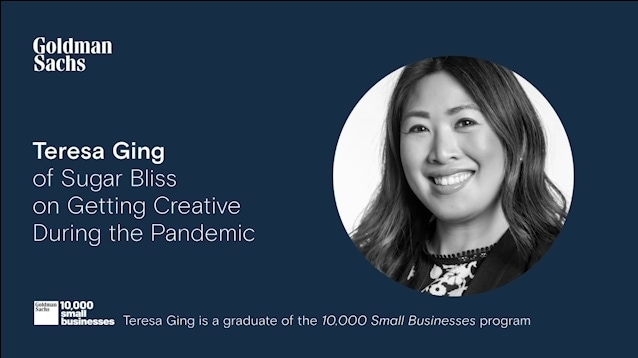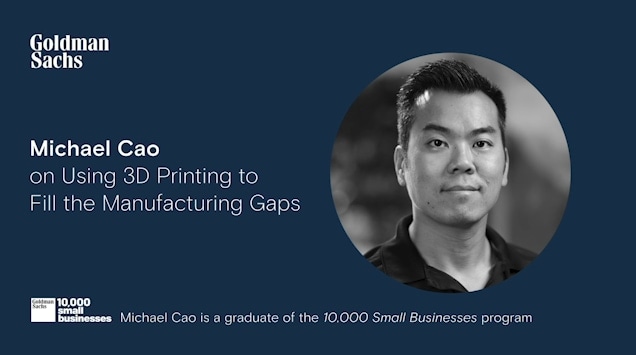The Small Business Pivot
The slowing economy and volatile markets are posing major challenges for those at the heart of the U.S. economy — small business owners. But despite inflation, rising rates and ongoing labor shortages, small business owners remain optimistic about the road ahead. From launching new shelf-stable products to accessing local partnerships, small business owners are tapping their creativity and resourcefulness to connect with customers. Our Pivot series follows the personal stories of seven graduates of the 10,000 Small Business program who are perfecting the art of the pivot.
Pivoting During the Pandemic

The pandemic, alongside an onslaught of economic challenges, has forced small business owners to find creative solutions to reach their customers. Today, many of those changes have led to new opportunities.
Like so many small business owners, Teresa Ging was forced to close her cakes and cupcakes storefront, Sugar Bliss, in downtown Chicago. Instead, she sold baked goods directly to her customers online, set up zoom baking classes and looked for corporate partnership opportunities. “Obviously, we had to pivot,” Ging says. “We had to start shipping more and developing care packages and do things differently…We had to think creatively to survive.”
Some of those temporary changes turned into permanent ones for Ging’s business. Years back, a major airline asked Ging if she had a packaged cookie line, which prompted her to work with a food scientist to develop shelf-stable cookies. Today, Sugar Bliss’ packaged cookies line is available in over 25 Walgreens in the Chicago area.
Ging, for her part, is still worried about a slowing economy — at a time when she’s planning to also raise prices because of her higher costs — but she believes people will continue to spend on “small luxuries” such as her $1 frosting shots. “I tell my staff when people come into our store they need to walk out extra happy — and they do.”
Filling the gaps, turning to partnerships and preparing for a downturn

The pandemic also proved to be an opportunity for Michael Cao, whose 3D printing company IC3D in Columbus, Ohio, was able to supply components for face shields during the height of the lockdown – at a time when the supply of such parts had dried up.
The value he sees in 3D printing is that it not only helps bridge those supply gaps but more generally makes manufacturing more accessible in the U.S. “What the pandemic did for 3D printing is it really showed a lot more people that it wasn’t just a technology or process to make toys or to make little models,” Cao says. “It showed the world that it could actually make functional things for society.”
Meanwhile, Cao is trying to address the housing shortage in Columbus, Ohio, by expanding his manufacturing processes into building 3D housing with concrete. “They’re not building homes fast enough to keep up with demand,” Cao says, adding that he sees the shortages as a problem partly caused by labor and materials shortages.
In a slowing economy, companies and entrepreneurs will look for lower-cost solutions and more efficient ways to source materials and find efficiencies in their processes, says Cao, who feels 3D printing will help serve as a low-cost solution in manufacturing. “When things get tough, economically people, entrepreneurs and big businesses by nature look for solutions. They don’t just close doors. It’s not that easy. So what happens is people are seeking lower-cost methods, more efficient ways to do things. And so that’s where 3D printing and advanced manufacturing in general are pretty resilient.”
Cao, who was in the first 10,000 Small Businesses cohort in Columbus, Ohio, has started to partner with other manufacturing companies to expand into new areas and capabilities. As a founder, Cao says he had struggled for years to be comfortable giving up control over aspects of his business but realized he needed to turn to others to fill in gaps.
Teresa Ging and Michael Cao are graduates of Goldman Sachs’ 10,000 Small Businesses program and shared their stories at Goldman Sachs’ 2022 10,000 Small Businesses Summit in Washington, D.C.
More from our 10,000 Small Businesses Pivot series:
Part 2: Small Business Owners Get Creative Amid Supply Chain Delays, Rising Costs
Part 3: Small Business Owners Find Community and a Voice Amid Crises
Our signature newsletter with insights and analysis from across the firm
By submitting this information, you agree that the information you are providing is subject to Goldman Sachs’ privacy policy and Terms of Use. You consent to receive our newletter via email.